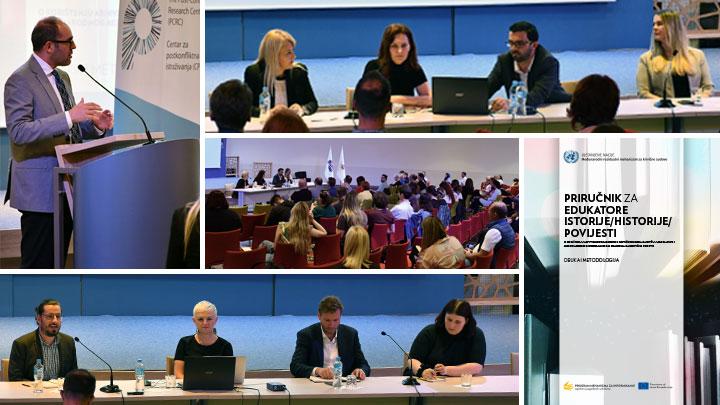Guide for History Teachers launched in Bosnia and Herzegovina

Today, the Mechanism Information Programme for Affected Communities (MIP) launched its Guide for History Teachers: How to Use Archival Material of the ICTY and Mechanism in Teaching the History of the 1990s Conflicts (Guide) in Sarajevo, Bosnia and Herzegovina.
The Guide was developed by the MIP in cooperation with the European Association of History Teachers (EuroClio) and representatives of teacher associations from across the former Yugoslavia. It is aimed at history teachers who wish to enhance their knowledge and skills in using the archival material of the International Criminal Tribunal for the former Yugoslavia (ICTY) and the International Residual Mechanism for Criminal Tribunals (Mechanism) when preparing history lessons on the 1990s conflicts in the former Yugoslavia.
Today’s event, comprising two panel discussions, was held at the premises of the Sarajevo Canton Memorial Fund (Fund) and was organised in cooperation with the Fund, the Post-Conflict Research Center (PCRC) and EuroClio.
The Political Advisor and Team Coordinator of the Delegation of the European Union to Bosnia and Herzegovina, Mr. Fermin Cordoba, opened the event and delivered remarks, during which he stated that: “Education should aim to contribute to mutual understanding and social healing, focusing on balancing the cognitive, the emotive and the ethical dimensions in history teaching and learning. Avoiding the politization of the past and fostering multi-perspectivity can certainly help.”
MIP coordinator Ms. Rada Pejić-Sremac then opened the first panel and spoke about the MIP’s activities and public information material. In discussing the significance of video production and its potential as an educational resource, she highlighted that the MIP has produced over 200 short videos and two online exhibitions utilising materials admitted into evidence in cases before the ICTY and the Mechanism. By doing so, the MIP has helped to make the judicially-established facts about crimes committed in the former Yugoslavia during the 1990s conflicts more accessible to the general public, and in particular to young people.
The other participants of the panel, Director of the Fund, Mr. Ahmed Kulanić, and Director of the PCRC, Ms. Velma Šarić, emphasised the importance of understanding and accepting the rich legacy of the ICTY and the Mechanism as a precondition for the processes of reconciliation in Bosnia and Herzegovina.
The second panel was opened by MIP Youth Outreach Coordinator Ms. Anisa Sućeska, who spoke about the MIP’s efforts in training more than 500 teachers from across the region of the former Yugoslavia on how to effectively use the ICTY and Mechanism archives when creating educational material related to the 1990s conflicts, and also discussed the development of the Guide. Ms. Sućeska stressed the importance of these workshops and the Guide in helping educators develop fact-based and engaging lectures about the region’s recent past, using records and judicially-established facts from both ICTY and Mechanism cases.
Next, EuroClio Program Manager Mr. Andreas Holtberg discussed the importance, as well as the challenges, of teaching about the conflicts of the 1990s in the former Yugoslavia, and presented the efforts of the EuroClio regional network to support these processes.
The second panel concluded with remarks by a group of 10 history teachers from the former Yugoslavia who contributed to the second volume of the Guide. This volume provides a set of lesson plans on the topics of: the Legacy of the ICTY and History Teaching; Children in War; Women in War; Destruction of Cultural Heritage; and Migrations. Two authors presented their respective chapters and shared their experiences in working on sensitive topics related to the 1990s conflicts with their colleagues from the region.
Funded by the European Union, the MIP aims to enhance the knowledge and understanding of citizens and communities in the countries of the former Yugoslavia regarding the crimes committed during the conflicts of the 1990s, drawing from ICTY and Mechanism cases.